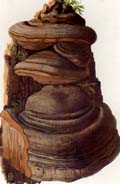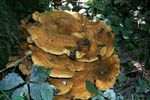Albatrellus caeruloporus
 Key to Gilled Mushrooms Key
Key to Gilled Mushrooms KeyThis is a key to gilled mushrooms, that is, mushrooms having a definite cap with a fertile surface consisting of gills. The fruiting body usually also has a stem, although that may be lateral or absent (usually, then, the mushroom is growing from wood). You can use this key to identify mushrooms that you find.
 Polyporaceae Family
Polyporaceae FamilyFertile surface usually a layer of vertical tubes, of which the mouths are visible as pores on the underside of the cap or shelf.
Fruiting bodies usually tougher or harder than the "normal" gilled mushrooms, being leathery, corky, or woody. But they can be quite tender while actively growing
Once grown, they do not decay easily, remaining on the substrate for months or years
They often grow on wood, although a few are terrestrial (even those are usually growing on buried wood)
Fruiting body is usually a flat shelf, or hoof-shaped, protruding directly from the substrate, although sometimes it may have a short stalk.
Some forms never grow away from the substrate at all, so that all that is visible of the fruiting body are the pores.
Sometimes the pores are so minute that the fertile surface seems solid, until you look closely
 Terrestriopolypore Subfamily
Terrestriopolypore SubfamilyGrowing on ground
 Medium Terrestriopolypore Tribe
Medium Terrestriopolypore TribeCap variable in size, but averaging 3-4"
Flesh soft, flexible, though it may dry hard and brittle
 Shortoporus Subtribe
Shortoporus SubtribeCap and stipe fleshy and substantial, flexible
Pores very short: 1-5 mm
Pore surface pale
Fruiting bodies irregular, often slightly lobed, stalk often off-center
Fruiting bodies sometimes clustered or compound, but more often singly or in troops
 Albatrellus Genus
Albatrellus GenusLightly colored - - at best pastel-ish.
Flexible flesh that often dries hard and brittle
Cap usually about 4" across, although their size is quite variable
Albatrellus caeruloporus (Peck) Pouzar
Here are the characters that distinguish this species from the others in its group. For its more general characters, see higher up on the page.
If there's just a few words or a microscopic feature here, a more thorough description can be found above.

Diagnosis
- Up to 2 1/4" across; slate blue to deep blue when fresh; drying greyish brown to reddish orange
-
Usually under hemlock






 Key to Gilled Mushrooms Key
Key to Gilled Mushrooms Key Polyporaceae Family
Polyporaceae Family Shortoporus Subtribe
Shortoporus Subtribe Albatrellus Genus
Albatrellus Genus





